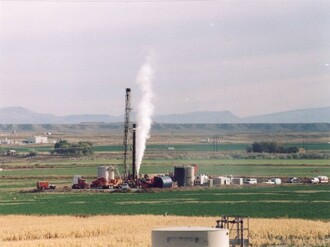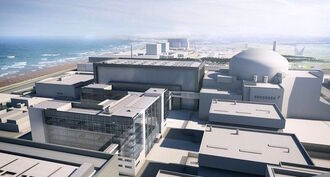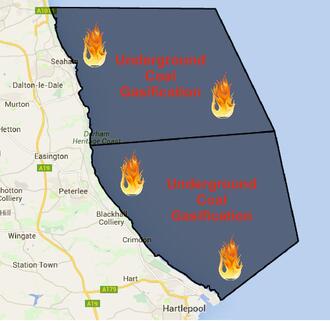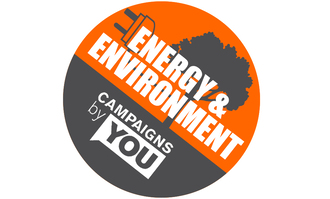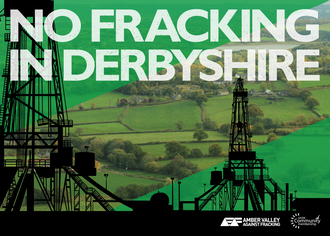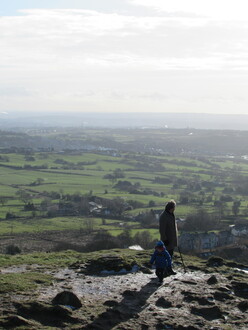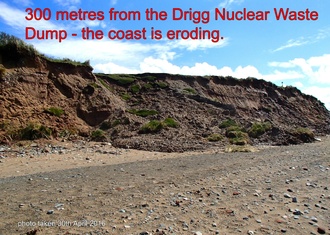-
Demand the Environment Agency properly monitors the air and water around UFF sites!Unconventional Fossil Fuels extraction and the Volatile Organic Compounds that are released as gasses and liquid spills are inherently dangerous, and we have plenty of evidence from other countries that it causes major damage to life and health. If this industry is to be allowed to operate in this country close to people they should be regulated and monitored stringently. If the cost has to come from the industry then so be it, we need to ensure that the public, animals and environment are safe, and so far with calls to the sites that have been active in the UK the response from the EA has been less than desirable; lying and failing in their duties. Millions of lives are at risk if these wells leak, we need to prevent this from happening. At this moment in time there is no public safety net from this industry who are releasing contaminants into the atmosphere.150 of 200 SignaturesCreated by Danny Llew
-
Cancel the Hinkley Point C nuclear reactor projectHinkley Point C is a vastly expensive project which has a good chance of failing, at great cost to UK electricity consumers. The model of reactor chosen for Hinkley Point C, the EPR (European Pressurised Reactor), is proving to be a technical disaster. Four are under construction in Finland, France and China and all overdue and over cost - the one in Finland is 9 years behind schedule. The cost of the Hinkley programme has escalated to £18billion and is likely to rise further. At present, the UK demand for electricity is falling and the cost of energy on world markets is also falling. Renewable technologies such as solar and wind are also rapidly becoming cheaper and represent far better value for money if we wish to invest in low-carbon electricity production. The Hinkley reactors will be funded by EDF, a company largely owned by the French government. Its finance director has resigned as he believes the company cannot afford the project. In order to attract investment in the project from France and China, the UK government has guaranteed a unit price for the power produced which is roughly three times the current price. This will inflate the electricity bills of all consumers for decades to come. Since it is a Government decision, it is effectively a tax which we can in no way avoid. A government which professes to believe in the free market has rigged the market by promising the French and Chinese investors a large return on their investment. Any profits will leave the country. Hinkley Point C is an infrastructure project that will end up as a white elephant. The next generation will not understand why we allowed such a grandiose project to be built. They will be left to pay the price through inflated electricity bills and to deal with the nuclear waste which the reactors will produce.411 of 500 SignaturesCreated by David Sang
-
PROTECT THE NORTHEAST COASTLINEWith Five Quarters nolonger in operation there is only Cluff Natural Resources with licences who want use the North East as a testbed for undersea coal gasification (UCG), an experimental method of squeezing out the remaining drops of coal. They have received licences to test down the NE coast from Seaham to Hartlepool In Australia linc energy UCG wells were found to leak the same substances to groundwater as can be released by fracking resulting in a 320km zone be made around the plant. There are dangers of blowbacks and explosions. Many test have failed. It has never been used on a commercial basis. The gas produced is syngas or coal gas. It is a mixture of methane (natural gas), carbon monoxide, carbon dioxide and hydrogen. They plan to pump it back into the hole they have made using Carbon Capture and Storage (CCS). This is another process that has not been fully tested. Surely it would be better to use renewables and not produce the CO2 in the first place? There is of course the carrot of job creation. Any jobs created by UCG/fracking will be highly specialised. However, if the same amounts of money were to be invested in renewable energies and/or home and public building insulation, which the public have been shown to prefer as the majority of surveys have shown. There would be far more new jobs and far fewer environmental concern's. For more information see Frackfreehartlepool.co.uk492 of 500 SignaturesCreated by David Spence
-
Remove monopoly for network distribution companiesWe are about to start a new build and have spent a year negotiating with SSEPD for an electricity connection. Their prices changed constantly, they sent the wrong contract to the Wayleaves team (the team that sort out the permissions with landowners) and then said that it was going to cost more because the works team had discovered a problem with the planned works on the quote. They say they won't tell us what the extra cost will be until they have done the work! So we have no idea if or what they might be planning to charge us on top of the amount we have already paid based on their quote.4 of 100 SignaturesCreated by Caroline McDonald Wood
-
Frack Free Cheshire EastGeorge, real people are struggling to deal with the effects of fracking in communities all over the world. From contaminated water that is unsafe to drink, wash and bathe in, through to the effects of poor air quality on health, damage to local economies through to the loss of tourism and agriculture and the decimation of areas of outstanding beauty and scientific interest. Here is a video link you might care to watch https://www.youtube.com/watch?v=V3K0kV7UcME. Fracking requires large numbers of wells (usually 8 per square mile), huge quantities of water that will be forever poisoned, and industrial development of the English countryside on an unprecedented scale whilst causing and not preventing a rise in greenhouse gases (shale gas and oil are fossil fuels and so emit greenhouse gases - did you know?). George you have scrapped the Green Charter at a time when many of our European cousins are investing heavily in green technologies, making huge innovative strides in solar and other renewable technology and banning fracking because of its inherent risks and dangers. Still more countries have extended temporary bans due to their concerns, to allow more time to thoroughly assess the dangers. Others that have already suffered the negative consequences of fracking are now taking measures to prevent further fracking. Oh and by the way - I can see no evidence that fracking will drive prices down at home here in the UK. There is no guarantee that gas fracked in this country would be used here. We, as you well know, are part of a free market economy so gas will be sold wherever it will generate the largest profits. Those profits will go back to the corporates and their shareholders, not our economy unless, of course, we manage to close all those pesky off shore loop holes by the time those profits are made (Starbucks anyone?). Meanwhile with oil prices scraping the bottom of the proverbial barrel and the price of solar electricity falling fast, the likes of Citibank say big power stations could be redundant in 10 - 20 years’ time! What then will happen to the wells George? Who will be responsible for their upkeep and/or decommissioning and at what cost environmentally and economically?. Where will the contaminated water go? Perhaps you are hoping it will just seep neatly away into the cracks caused by fracking (along with the other 60% of water that 'goes missing' during the fracking process), that is assuming that the wells are even up and running by this deadline. Me? I like my water fresh from the tap, preferably uncontaminated. Fracking has the very real potential to adversely affect the food we eat, the water we drink, the air we breathe and the ground we walk on (remember the earthquakes George, that Cuadrilla admitted to causing?). Therefore we, the undersigned, request an immediate cessation to this Government's pro-fracking policies and any pro-fracking activity currently taking place until a thorough INDEPENDENT, cross party, scientific analysis and review has taken place with any research and conclusions reached made transparent and fully available to the public. We thank you for your earliest attention in this matter.152 of 200 SignaturesCreated by Nicola Wilson
-
No to fracking in Altrincham and Trafford!Much of this borough is semi rural. We do not want to see our green spaces industrialised with up to 8 wells per square mile. Our roads are congested enough without the massive increase in heavy traffic these developments would cause. Fracking can potentially lead to serious or widespread pollution of our water supplies. And there is the risk of air pollution too. High-profile doctors, pharmacists and public health academics want fracking banned! We do not want these risks near our homes and schools! It could reduce the value of our homes! We do not want to risk negative equity and losing the value of our hard work! We already risk dangerous climate change by the burning of just a fraction of the fossil fuels that we have found! Just what is the point of destroying our environment just to look for more? If we stick to the goals to limit global warming to 2degrees, we will never be able to burn shale gas!172 of 200 SignaturesCreated by Jane Katz
-
Call on the Scottish National Portrait Gallery to cut ties with BP!We, the undersigned, care deeply about the arts, and equally the natural environment and the rights of humans around the world. We believe arts and cultural institutions should break their ties with oil companies such as BP, a company which has caused repeated environmental catastrophes, including the Deepwater Horizon spill, and been implicated in numerous human rights violations. Furthermore, BP is turning a profit on the continued extraction of dirty fossil fuels, pushing us towards runaway climate change, whilst lobbying against environmental laws and clean energy alternatives [1, 2]. By accepting sponsorship from BP, cultural institutions give the oil giant much-needed positive publicity, and help it to obscure the destructive reality of its activities with a veneer of respectability. At the same time, oil sponsorship taints the reputation of the institutions that accept it. We recognise the vital importance of arts funding, particularly after public funding cuts. However BP sponsorship provides less than 1% of the annual income of the British Museum, Tate, and Royal Opera House, and just 3% of the income of the National Portrait Gallery [3], yet BP are allowed to place their name and logo alongside the names of these institutions, on their website and in exhibitions (despite many artists and arts workers having strong views against such branding) [4, 5]. BP needs these institutions far more than they need BP. This is the 26th year that BP has sponsored the Portrait Awards, through an agreement with the National Portait Gallery (NPG) in London. Fortunately this agreement is due to end this year. The NPG could choose not to renew the agreement, and to find a more appropriate sponsor for the Portrait Awards. However, negotiations about renewal are already underway. The NPG will not drop BP as a sponsor without strong pressure from the public and the arts sector. We need to act now. Over its 26 years of sponsorship, BP has repeatedly caused great harms to the environment and people; it has been responsible for multiple deadly explosions and oil spillages, including that of Deepwater Horizon, which killed 11 people, decimated ecosystems and livelihoods in the Gulf of Mexico, and resulted in the largest corporate fine in history [6]. It has traded with oppressive regimes from Azerbaijan to Libya, and has even been implicated in torture in Colombia [7]. It has recently expanded into tar sands, an extreme form of energy production which contaminates water and tramples on indigenous rights [8]. Worldwide, fossil fuel companies have currently laid claim to five times the volume of oil, gas and coal that humanity can burn without causing dangerous and destructive levels of global warming [9] - despite this, BP has stated that it will continue to explore and exploit new reserves of oil and gas into the future. In 1989, the National Portrait Gallery ended its eight-year Portrait Award sponsorship agreement with tobacco company John Player [10]. It is time for this national cultural institution to show such moral leadership and forward-thinking once again, by cutting ties with BP. As a partner of the National Portrait Gallery, the Scottish National Portrait Gallery can influence this decision. We call on this respected national cultural institution to put pressure on the NPG to find a more appropriate sponsor, and to refuse to host the BP Portrait Awards until a new sponsor has been found. For more information, please see: http://bp-or-not-bp.org/ http://bp-or-not-bp.org/scotland http://platformlondon.org/p-publications/picturethis/ References 1. http://www.theguardian.com/business/2010/may/02/bp-deepwater-horizon-oil-spills 2. http://www.theguardian.com/environment/2015/sep/21/bp-tops-the-list-of-firms-obstructing-climate-action-in-europe 3. http://platformlondon.org/p-publications/artoilinfographic/ 4. http://fossilfundsfree.org/who/ 5. http://www.theguardian.com/artanddesign/2014/jun/24/no-oil-painting-bp-sponsorship-npg-portrait-award 6. http://www.theguardian.com/environment/2015/jul/02/bp-will-pay-largest-environmental-fine-in-us-history-for-gulf-oil-spill 7. http://www.theguardian.com/world/2015/may/22/gilberto-torres-survived-colombias-death-squads-now-he-wants-justice 8. http://environmentaldefence.ca/reports/canadas-toxic-tar-sands-most-destructive-project-earth 9. http://www.rollingstone.com/politics/news/global-warmings-terrifying-new-math-20120719 10. http://platformlondon.org/p-publications/picturethis/ 11. http://www.scientificamerican.com/article/climate-risks-as-conclusive-as-link-between-smoking-and-lung-cancer/176 of 200 SignaturesCreated by Claire Robertson
-
Stop Fossil Fuel SubsidiesIf we are to stop global warming we need to move away from a Fossil Fuelled society to a world which exists on renewable energies. Renewable energies receive little or no subsidy, whereas Mega Rich MNCs receive millions of £'s in of taxpayers money in the form of subsidies from the British Government. Whereas in reality subsidies should be directed to help with the development of renewable energy services as well as helping people living in fuel poverty become recipients of renewable energies.12 of 100 SignaturesCreated by Pau Bayliss
-
Keep Barnsley Frack FreeWe are concerned that fracking could: • Contaminate our water supply • Pollute the air with hazardous chemicals • Cause earthquakes • Reduce the value of our homes • Increase our insurance premiums • Make our roads less safe by increasing heavy traffic • Leak methane, which is a potent greenhouse gas 80 times more powerful than carbon dioxide • Cause illness in local populations • Increase noise and light pollution from drilling operations and traffic movement. Fracking is bad for our environment, bad for our communities and we call upon Barnsley Council to reject fracking in Barnsley.2,896 of 3,000 SignaturesCreated by Andy Hemingway
-
No Fracking in Amber ValleyWe are told that Hydraulic Fracturing (Fracking) will create jobs and lower your energy prices. While this is extremely debatable and has been discredited by many authorities, there are many other environmental and economic facts to be considered. The detrimental effects of Fracking are well documented. Some of the key facts are as follows: Fracking increases local air pollution An increase in risk of pollution to local drinking water supplies Possible Risks of seismic activity Threatens natural habitats Fracking generates massive amounts of greenhouse gases Investments in Fracking blocks the development of renewable energy Increased traffic on roads from site vehicles Potential to lower the value of your house if located near a site for the above reasons Scotland, France and Germany have already banned Fracking. Please help give your support by signing this petition to let the local government that Amber Valley's constituents wish it to remain a Frack free area. Please also see details of our first meeting here: https://www.facebook.com/events/568058916702507/ Or here: https://you.38degrees.org.uk/events/fracking-in-amber-valley1,350 of 2,000 SignaturesCreated by Lee Burrows

-
No to Fracking in North StaffordshireFracking gets a lot of attention and rightly so. THere are the environmental aspects of the government striving to grow the burning of fossil fuels of which 'Frackgas' is one of them. The pollution aspect is even more painful with metals such as; arsenic, mercury, cadmium being brought to the surface for clean up. The cost to the communities will be through a massive cost to the Water companies who will pass these additional costs on to their customers. Millions of tonnes of chemical impregnated water will be used in the 'frackgas' operation and it will all need to be treated. Where will the cleaned pollutant residue end up? We have yet to gain an answer to this. Let us look at the visual impact. Stoke on Trent could end up with some 30 derricks blotting the landscape. We know that we have miles upon miles of coal bed methane trapped under our city and towns. There is this licence for 'Frackgas' or the dangerous technique of fracking coal bed methane. This is your country: Protect It518 of 600 SignaturesCreated by Sean Adam
-
Lock the Gate on Drigg -No More Nuclear WasteTo describe the UKs nuclear waste site as a “Repository” is putting a spin on the UKs main nuclear dump for "low level" waste. There is "controlled discharge direct to the Irish Sea" not to mention run off to the Drigg Stream and River Irt. Discharges to the air of radioactive gases are ongoing. According to the British Geological Society the Drigg site is above a regional aquifer. It is also "likely to be destroyed by coastal erosion" in 500 to 5000 years (computer modelling can be wrong either way) . Much of the waste is long lived and high risk. Below are a few of the reasons why it is important that Cumbria County Council Lock the Gate on Drigg: Planning Application PL\1508\05 (4/15/9012):The phased construction of additional vaults, higher stacking of containers..capping.. 1. Drigg Low Level Waste Repository (the word nuclear was dropped so as not to scare the horses) would continue to accept nuclear waste for decades to come. "Capping" is misleading. To cap” a nuclear dump is akin to putting a cap on a fizzy lemonade bottle while there are holes in the bottom of the bottle. The site will continue to leach aqueous emissions to groundwater and gaseous emissions to air. 2. LOW LEVEL: This suggests that the waste at Drigg is low risk and short lived. Neither is true. As the University of Reading has pointed out: “The Drigg site uses two disposal systems: 1) An original system operated from 1959 to 1988 comprising a series of parallel trenches excavated into glacial clays, back filled with LLW and covered with an interim water resistant cap. 2) Current disposal of compacted waste placed in steel ISO-freight containers, with void space filled with highly fluid cement based grout. These containers are then disposed of in a series of open concrete vaults. Radionuclides with highest activities in the inventory include 3H, 241Pu, 137Cs, 234U and 90Sr, 238U and 232Th. http://centaur.reading.ac.uk/16608/1/mrspaper.pdf 3. RADIOACTIVE FLY TIPPING: The chemical and nuclear dump site has moved on from the years 1940 to 1988 when chemical and radioactive waste was tumble tipped into trenches. Now the waste is compacted into steel shipping containers filled with cement. Incredibly the containers are stacked high. In 2013 the LLW management wrote: “in containers at the tops of stacks, the external capping grout has undergone extensive physical degradation and settlement; the lids are not full of grout, and the grout is generally heavily cracked. The state of the capping grout in underlying layers is better; most containers only show sparse cracking and typical settlement in the lid is approximately 15 mm. Standing water, sometimes contaminated with low levels of radioactivity, is present in approximately half of the containers at the tops of stacks. ..In containers at the tops of stacks, organic matter has accumulated beneath many open grout ports, with vegetation growing from some grout ports. ..Corrosion, sometimes fully penetrating, is present in some container lids at the tops of stacks…” http://llwrsite.com/wp-content/uploads/2013/11/30-RP-LLWRGR-PROJ-0139-Vault-8-Container-Issues-Project-MAS.pdf 4. FLOODWATER AND SEA INUNDATION: “The Environment Agency has given a formal view that “the potential for disruption of the site is an acceptable risk” By “disruption of the site” they mean inundation by sea and flood. This is a far cry from the Environment Agency's previous criticism in 2005: "BNFL (Now the NDA) has not yet demonstrated that the wider benefits to the UK from continued LLW disposal on this site outweigh the potential future impacts" We would hope that Cumbria County Council agree with the Environment Agency's 2005 findings that that the real and present threat of inundation of the Drigg site by flood or by sea is not an acceptable risk to the people of Cumbria or to our international neighbours. 5. THE COLLAPSE in 1985 of the largest black-headed gull breeding colony in Europe on the Drigg dunes has never been satisfactorily explained. The official explanation is that a fox did it! https://mariannewildart.wordpress.com/2015/12/29/disappearing-trick-birds-and-nuclear-waste/ 6. CHILDHOOD LEUKEMIA is officially blamed on "population mixing" due to the influx of workers firstly to the 1940 explosives factory (Royal Ordnance Factory) at Drigg and then the ROF at Sellafield. The irony of this incredible argument is that the plan for 3 new nuclear reactors at ' Moorside' a few miles from Drigg ('Moorside' is at the village of Beckermet) would involve a boom and bust influx of thousands of workers along with a further tsunami of nuclear wastes and ever more Driggs. https://you.38degrees.org.uk/petitions/stop-moorside-biggest-nuclear-development-in-europe Many of the Councillors expressed serious concerns at the meeting and yet the vote was unanimously in favour which, to campaigners and the wider public, smacks of something very fishy indeed. To rely on the testament of the Environment Agency who merely look at the information provided to them by the industry is reckless. All projections and computer modelling are based on information provided by the operators. Much of the Drigg site is already unable to be accessed for monitoring due to the stacking of containers. At the planning meeting on 15th July 2016 There was no discussion of a. the increased possibility of criticality with an ever increasing radiological burden. The words criticality “will not occur” cannot be applied to Drigg's LLWR : https://mariannewildart.wordpress.com/2016/08/02/drigg-decision-we-are-caught-in-a-trap-no-way-out-because-we-love-nuclear-waste-too-much/ b. the ethics of denying future generations the right to protect themselves, c. whether to warn future generations not to dig or distrurb the poisonous chalice beneath the land. d. the ethics of adding to an already intolerable radioactive burden on this vulnerable coastal site.2,221 of 3,000 SignaturesCreated by Marianne Birkby
Hello! We use cookies to improve your experience by providing insights into how the site is being used. Find out more.
